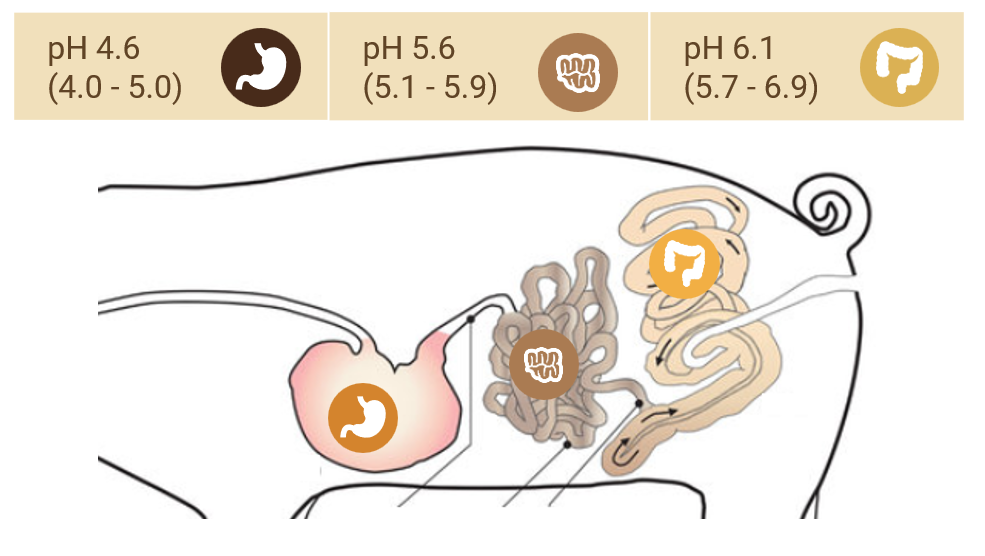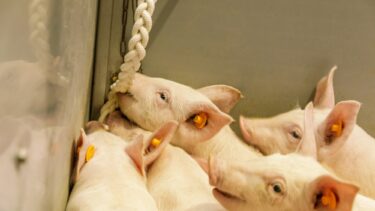Keep in mind the acid-binding value of piglet feed
The acid-binding value of a raw feed material is the degree to which the raw material is resistant to a pH change. This acid-binding value is of great importance in piglet feeds, as the gastrointestinal system of piglets is not yet fully developed around weaning. Also at this time, the parietal cells in the stomach of piglets do not produce sufficient acid to significantly reduce the pH in the stomach. Despite these challenges, it is possible to create the optimal gastric pH important for both the digestibility of the feed and the prevention of intestinal problems.
What is the acid-binding value
The acid-binding value is defined as the quantity of acid needed to change the pH of one kilogram of raw material/feed to the titration endpoint pH. This titration endpoint pH may be pH 3 (ABC-3) or pH 4 (ABC-4). If the pH of a raw material is lower than the end value (like with organic acids), a base will be needed for the ABC determination and the ABC value will be negative. The acid-binding value is expressed as mEq per kg of raw material. Preferably the ABC-4 is used for piglets, because the pH in the stomach of recently weaned piglets will vary around this value.
pH of a piglet’s gastrointestinal tract

Piglet feed requirements
A feed with a sufficiently low acid-binding value is important to minimise the weaning dip. This is because, before weaning, the stomach is acidified by the bacterial conversion of lactose to lactic acid by lactic acid bacteria in the stomach of piglets. After weaning, piglets have trouble keeping the gastric pH sufficiently low. The combination of a not yet fully developed acid production in the stomach of piglets, a lack of sufficient lactose as a substrate for lactic acid production, and irregular feed consumption will often cause the pH in the stomach of piglets to rise above 5. Nuscience’s own measurements show that the pH in the stomach of piglets still rises above 4 even 4 weeks after weaning. It is not until the age of 7-10 weeks that the gastric acid secretion of piglets has fully developed.
The gastric pH of piglets needs to be around 3.5 for optimal digestion and health. Therefore, a low acid-biding value of the feed will cause the pH to return to the desired value soon after feed intake. Maintaining an optimal pH in the stomach of piglets is very important to the performance and health of piglets for various reasons:
- Acts as a natural barrier to pathogens, since many pathogens cannot develop at a pH below 4
- Promotes protein digestion of pepsinogen into pepsin as a low pH is important for its conversion
- Lowers digestion problems that lead to diarrhea due to the undigested protein being fermented in the large intestine
- Increases the effectiveness of specific ingredients such as medium-chain fatty acids
- Slows gastric emptying to have a positive effect on the digestibility of the feed
Several studies clearly demonstrate that, in piglets, a feed with a lower acid-binding value results in better growth and feed conversion. For example, Lawlor et al. (2006) demonstrated a reduction of the acid-binding value from 500 mEq/kg to 340 mEq/kg resulted in 4.5% better piglet growth in the period from weaning to 4 weeks after weaning.
Impact of ingredients
Raw materials with a high acid-binding value will have a stronger effect on the neutralization of the gastric pH. In the choice of raw materials, it is therefore important to pay attention to the acid-binding value. Since binding value is related to protein and mineral content, high-protein and high-mineral raw materials will have a high acid-binding capacity. On the other hand, organic acids have a negative acid-binding value and can reduce the acid-binding value of the feed. The figure below shows the average acid-binding values of some commonly used raw materials (Figure 2).

In the figure above, it is clear that zinc oxide (ZnO) has a high acid-binding value. This is something that is often overlooked when therapeutic doses of zinc oxide are used. It is also apparent that therapeutic doses of ZnO almost completely cancel the effect of organic acids. Similarly organic acids can be used to eliminate the negative impact of ZnO on the acid-binding value. As Europe has entered an era with the banned use of medicinal ZnO, it is important to re-evaluate the acid use in piglet diets, as high acid use can have a negative effect on feed intake.
For their growth and bone strength, piglets have a high demand for calcium. However, the figure above also shows that calcium sources have a notable effect on the acid-binding value of the complete feed. Therefore the calcium quantity, content, and source are very important in determining the final acidity of piglet feed.
With a well-balanced combination of phytase, calcium sources, and pH-reducing acids, Earlyfeed optimizes the acid-binding value of piglet feed in its Vitastart concentrates. These support the piglet’s ability to develop secure intestinal health and to achieve its full growth potential in an economic manner.
This contact was suggested based on the location you are browsing from. You can of course also consult our other contacts and locations here.

